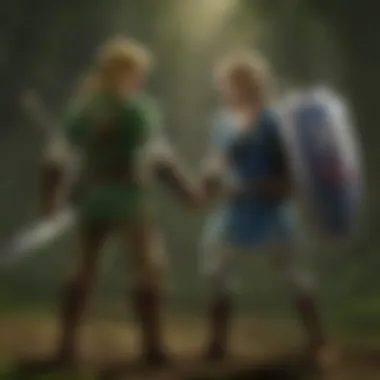Exploring The Legend of Zelda for Wii: A Deep Dive


Intro
The Legend of Zelda series has always been a cornerstone of gaming lore. Specifically, the titles released for the Wii console marked a significant evolution in gameplay, narrative, and player engagement. In this examination, we explore the richness embedded within these games, merging both critical perspectives and fan insights.
Through highlighting various aspects such as gameplay mechanics, character intricacies, stunning visuals, and the memorable narratives of these adventures, we illustrate how the Wii platform brings unique elements to the well-known experience of navigating Hyrule.
We will systematically investigate the impact of these games culturally and critically. The findings aim to cater not only to disdainful critics looking for examination but also new players drawn into the enchanting world created by Nintendo.
Game Reviews
Gameplay Features and Mechanics
The gameplay on the Wii is a standout due to its innovative controls. The motion sensing accelerates immersion, providing players with interactive opportunities to manipulate objects, wield weapons, and perform sword actions. Titles like The Legend of Zelda: Twilight Princess fully utilize this control scheme while maintaining the rich puzzle and action variety fans expect. The use of the nunchuk combined with the Wii remote facilitated a new combat system, prompting players to engage more vigorously with enemies and puzzles.
Storyline and Quests
The narratives delivered in these titles are deeply rooted in the familiar Zelda lore, yet they showcase innovation. For instance, Skyward Sword unveils the series' origins, linking past stories with contemporary storytelling. Each adventure offers quests that combine exploration with purpose, creating a deeply satisfying arc that encompasses character growth and an unraveling mystery. Fans can explore themes such as courage, friendship, and the eternal struggle against darkness in these quests.
Visuals and Sound Design
The graphics for the Wii were a significant leap when compared to earlier generations. With art styles varying, Twilight Princess embraced a more realistic approach while Skyward Sword goes for a vibrant, painterly style. The soundscapes provided an additional layer of depth. Musical scores captured emotional intensity, bringing environments and actions to life. Players found this design aesthetic pivotal in building atmosphere throughout their journeys in Hyrule.
Comparison with Previous Titles
Nintendo appears committed to evolution with each installment. Compared to earlier titles like Ocarina of Time or Wind Waker, the Wii installments introduced a dynamic gameplay element lacking prior iterations. Engaging in casual funny moments made these experiences distinct. New techniques, environments, and supporting characters juxtapose respected classics, illustrating how every title has its unique flavor even within the franchise's overarching narrative.
The richly woven narratives and dynamic gameplay mechanics add dimensions that have been pleasurable whether you are a newcomer or a seasoned adventurer in Hyrule.
Intro to The Legend of Zelda
The Legend of Zelda is more than a mere video game franchise; it is a remarkable cultural artifact that has transcended generations. This article aims to explore the significance of The Legend of Zelda series, particularly within the context of the Nintendo Wii titles. Several key elements draw attention to this exploration. The impact of the franchise not just in gaming but in popular culture at large is unmatched. Its narrative depth, intricate gameplay mechanics, and character development provide an extensive canvas for analysis.
The Genesis of the Franchise
The Legend of Zelda was first introduced to the public in 1986. While the original gameplay was innovative at its release, it provided game design approaches that were groundbreaking. The concept of an interactive world, filled with exploration and puzzle-solving, was unique. The fundamental gameplay involved a mix of action, adventure, and RPG elements that set a prototype for infinite game design in the industry.
The vision of its creator, Shigeru Miyamoto, along with Takashi Tezuka, led the development of the series wrapped in exploration, discovery, and the advent of heroic quests. Over the decades, titles have evolved while maintaining core gameplay elements. This lineage offers much detail for enthusiasts who analyze how design transformations occurred, especially with the advent of the Wii console.
Zelda's Cultural Significance
The importance of The Legend of Zelda goes well beyond gameplay. It has instigated a cultural significance that resonates with various age groups. The franchise stands as a paragon of storytelling in video games. Each title often initiates thoughtful discourse among fans regarding themes of heroism, morality, and the quest of self-discovery.
The series has inspired art, music, and fan fiction, allowing numerous cultural explorations. The memorable scores and creative character designs contribute to a universe that continues to attract and captivate. The relationship between players and the fictional world underscores an emotional experience that solidifies the series' enduring legacy.
Zelda emphasizes both a quest of the hero and a reflection of one’s personal journey.


In terms of players' engagement, analysis has revealed fascinating patterns of how legendary characters, such as Link and Zelda, have become embodiments of aspiration and courage. Through exploring these aspects, readers can relate to intricate themes woven through gameplay.
In the forthcoming sections, we will analyze specific Wii titles like Twilight Princess and Skyward Sword, shedding light on what makes The Legend of Zelda series monumental in the gaming sphere and beyond.
The Legend of Zelda: Twilight Princess
Overview and Gameplay Mechanics
The Legend of Zelda: Twilight Princess stands as a pivotal title within the franchise. It’s notable for its expansive gameplay mechanics and deeper storyline than previous entries. Released in 2006 for the Wii, it brought innovative elements that took advantage of the console's unique controls. The addition of motion-sensing technology allowed for more immersive swordplay and puzzle-solving. These mechanics enhanced player engagement by offering a fresh experience with the series. For instance, the waiving of the Wii-mote became integral to combat sequences, giving players a physical connection to the protagonist’s battles.
Players traverse the kingdom of Hyrule in both human form as Link and wolf form after a transformative change that deepens the game's narrative and mechanics. The utilization of two forms creates diverse gameplay challenges that enhance both strategy and exploration. Dungeons vary significantly, offering engaging puzzles and combat scenarios that require players to switch between abilities, maintaining a blend of action and thought.
Narrative Structure and Themes
Twilight Princess embodies darker themes compared to its antecedents. The narrative unfolds in a richly constructed world suffering from blight brought by the Twilight Realm. The struggle against these lurking shadows introduces compelling themes of light versus darkness. Moreover, the transformation of Link into a wolf symbolizes the duality of human nature and the power struggle within. This intensified personal journey fosters emotional connections with players, inviting them into a tale that intertwines the destinies of Link, Zelda, and the land of Hyrule.
The storytelling structure is primarily linear but reinvigorated through character interactions and lore exploration. As players engage with secondary characters, the layers of history surrounding Hyrule begin to emerge. A prominent aspect is the role of Ganondorf as an antagonist. With significant involvement, he deepen links in a classic conflict of evil versus hero, grounding the plot in a broader context of the franchise's ongoing narrative legacy.
Character Analysis: Link and Zelda
Link, as the central character, embodies the traits of courage and resilience. In Twilight Princess, his character development is significant. He is no longer simply a hero; he evolves into a figure of a tragic past, whose 성장 is illustrates via the pressures he faces during the dual-responsibility of confronting the Twilight and restoring Hyrule.
Zelda, traditionally viewed as the damsel in distress, breaks away from this mold in Twilight Princess. Portrayed as a multifaceted leader clouded by secrets, she plays a crucial role in the overall narrative. Her complex dynamic with Link unfolds layers of emotional depth, positioning them not just as hero and princess but as intertwined souls navigating through a world marred by darkness.
Reception and Impact
Upon its release, Twilight Princess was highly praised for its graphics, gameplay innovations, and thematic depth. It achieved significant commercial success, quickly becoming one of the best-selling titles on the Wii. Critics recognized the incorporation of both nostalgic elements and refreshing new experiences, offering an experience that appealed to long-time fans while welcoming new players.
Notably, its darker tones and mature themes garnered attention. This narrative shift opened avenues for discussion among players regarding the evolution of video game storytelling. Fans embraced the complexity of Twilight Princess, which is often contrasted with other installments in the series that followed. The impact of the title extends well beyond sales. It increased the expectations players have for future Zelda titles in terms of storytelling, design, and emotional investment in characters.
Twilight Princess not only redefined gameplay mechanics but also expanded how narratives could be woven into the Zelda fabric, illuminating possibilities for the franchise.
This game fostered deeper engagement with the Zelda universe, making it a critical reference for developments in the series. In essence, it solidified its relevance in gaming history."
The Legend of Zelda: Skyward Sword
The Legend of Zelda: Skyward Sword represents a pivotal moment in the franchise’s timeline. Released in 2011 for the Nintendo Wii, this title introduced innovative gameplay enhancements while enriching the overarching lore of Hyrule. As players navigate through a world set within the origins of the series, they engage with mechanics that redefine interaction within the game environment. The importance of this title lies not just in its unique control scheme but also in the deeper narrative it unveils.
Gameplay Innovations and Controls
Skyward Sword is particularly noted for its innovative use of motion controls. The game integrated the Wii MotionPlus accessory, providing precise control for sword fighting and other actions. Here, players actively swing the sword to attack, making timing and direction crucial to combat. This approach transforms each engagement into a thoughtfully choreographed duel, adding sophistication to the combat.
Well-crafted puzzles further highlight the gameplay innovations. Players manipulate multiple elements within the world by using items that require momentum or accuracy. Whether it is directing gusts of wind or rotating distant objects, every interaction reinforces the immersive qualities of HWYRUSe before.
The Origins of Hyrule: A Lore Perspective


Plot-wise, Skyward Sword serves as a foundational tale. It establishes the legend of Hyrule and gives context to the recurring battles between Link and the dark forces embodying evil. Players uncover the origins of the Master Sword, realizing the deep connections between the characters and the ever-evolving land of Hyrule. This timeline elite speaks to the cyclical nature of conflict and resolution, a theme that resounds throughout the Zelda franchise.
A critical aspect screened is the relationship dynamics between characters. Link, Zelda, and Groose highlight themes of courage, friendship, and personal growth, providing players with evolving motivations and emotional stakes, enriching their journey and discovery.
Exploring Character Dynamics
The character arcs presented in Skyward Sword are remarkable. Link is portrayed not merely as a static hero but as an evolving figure who embodies the ethos of courage. The changes he undergoes are reflective of external struggles while also deeply resonating on a personal level. In contrast, Zelda is often tied to her lineage and responsibilities, dealing with the burdens that come with big decisions.
Moreover, Groose provides a crucial layer of character dynamics. Initially introduced as self-absorbed and competitive, his growth into an ally reveals how solidarity can emerge from rivalry. By offering lighter moments and more contrasting paths, Groose’s character development enriches the narrative fabric. In this title, the relational exploration goes beyond a mere background, becoming instrumental in driving the plot forward.
Fan Reception and Legacy
Upon its release, Skyward Sword obtained mixed responses, primarily regarding its control schemes and motion sensitivities. While some players celebrated the innovation, others found frustrations linked to calibration. However, these issues did not overshadow the game's constructive legacy.
The incorporation of motion controls set a precedent, albeit divided among fans, facilitating further experimentation in following Nintendo titles, thus forming unbreakable connections in the Zelda series' history. Popularity surfaced in the cultural dialogues initiated online, leveraging platforms such as reddit.com, engaging various enthusiasts who appreciate nuanced game design.
Ultimately, Skyward Sword grows more appreciated over time through deeper discourse within fandom, helping to bind ascendantities from the older platform! Through retrospective appraisals, it has secured its rank among Zelda productions, signifying growth in response expectations and critical arrival over generational tables.
Comparative Analysis of the Wii Titles
A comparative analysis of the Zelda titles on the Wii serves as a crucial part of understanding the evolution of gameplay, narrative depth, and immersive experiences in this legendary franchise. Each title, while uniquely distinct, embodies a specific production philosophy informed by advancements in technology and gameplay preferences. By scrutinizing these titles, we can reveal how different mechanics, story arcs, and design choices resonate with players, lifting the veil on why certain games have become enduring classics.
Game Mechanics: A Side-by-Side Review
In examining The Legend of Zelda: Twilight Princess and The Legend of Zelda: Skyward Sword, the variations in game mechanics are striking. Twilight Princess relies on conventional button pressing, which creates a more traditional gaming experience. Link traverses through darker landscapes with a focus on adventure and puzzle-solving. Combat focuses on timing and strategy, allowing for a challenging encounter with enemies.
On the other hand, Skyward Sword introduces motion controls utilizing the Wii Remote. This innovation transforms how players interact with the game world, offering a more physically engaging gameplay. The responses mirror the motions taken by players, giving a unique real-time aspect to swordplay and interactions with the environment. Each swing, thrust, or swing becomes a part of the complex interactions with adversities.
Comparing these mechanics yields significant insights. While some players value the responsiveness and immersion of motion controls in Skyward Sword, others appreciate the straightforward approach of Twilight Princess. Both games allow players to explore vast worlds, thus understanding player preferences becomes fundamental in discussions surrounding their success.
Narrative and Themes: Contrasts and Comparisons
The narratives embedded within Twilight Princess and Skyward Sword present complexities worth investigating. Twilight Princess builds a theme of darkness and despair contrasting with the light and idealism abundant in Skyward Sword. Twilight Princess, with its darker hues and sense of unease, captures the emotional depth of characters like Midna, revealing darker truths about courage and heroism.
In contrast, Skyward Sword emphasizes the foundational lore of Hyrule. It steps into a narrative that paves the path to future titles by exploring themes such as destiny, friendship, and courage. The game encapsulates legendary stakes, unraveling the origin of famous characters while treating the player to beautiful animation and centered dialogue.
These contrasting narratives reflect changes in audience expectations and available storytelling techniques during their releases, signifying notable developments in game design philosophy.
Visual and Audio Design Elements
Visuals and audio play paramount roles in enhancing immersion within both Twilight Princess and Skyward Sword. Graphics of Twilight Princess carry a sense of stylization, basking in its darker palette. Characters like Link introduce depth, enabling audiences to appreciate shadow and light interplay. The sepia-toned environments significantlly augment the mysterious atmosphere.
Conversely, Skyward Sword employs a vibrant watercolor aesthetic. This artistic choice denotes not just a stylistic preference but illustrates an shift towards brighter, more appealing imagery, distinguishing itself visually from prior titles. Each area explored, from the skies to the soil, captures an essence of discovery with lush landscapes and intricate details.
Accompanying these visuals is exemplary audio design. Twilight Princess presents a score that resonates with emotional undercurrents, while Skyward Sword’s music complements its more lively gameplay, wooing players into engaging instantly. The use of ambient sounds places willingly players into the heart of Hyrule, convincing sense of involvement.


To understand future Zelda offerings, one must first dissect these transitional chapters.
- Evaluating mechanics provides insights into player experience
- The storytelling transitions elevate narrative exploration er
- Artistic representations define the emotional connections made by players
The Evolution of Zelda on Nintendo Consoles
From Past Consoles to Wii
The transformation of The Legend of Zelda on Nintendo consoles is a pivotal narrative in the gaming world. Beginning with the original title in 1986, Zelda evolved over the years, adapting to new hardware and audience expectations. Each installment built on previous experiences, setting new benchmarks in gameplay and storytelling. The transition to the Wii marked a significant milestone due to its motion controls and unique interface.
The Wii's launch in 2006 coincided with a period of growing demand for interactive gaming experiences. Players desired more immersive gaming than what previous consoles offered. The Legend of Zelda: Twilight Princess embraced this shift directly. With its ability to incorporate motion sensing aimed at enhancing exploration and accuracy in gameplay, players found new depths in the familiar mechanics. The iteration created for this console made these mechanics engaging in ways not seen previously. Link's swordplay became not just animated reactions but an interactive simulation of real movements. This integration of effort was crucial to how the franchise remained relevant and appealing during this transition.
Key points in this transition can be noted:
- Increased Interactivity: Players used the Wii Remote to interact with the game, changing how players connected with the character.
- Visual Enhancements: Updated graphics made the rendition of Hyrule more detailed fluidity.
- Accessibility: The console's format brought Zelda to a broader audience, capturing new fans, particularly families.
Overall, examining these developments showcases the strategic changes made during this period. Zelda's transformation was essential for retaining its status and accessibility in the gaming market.
Future Directions and Speculations
When contemplating the future directions for The Legend of Zelda series, several considerations emerge. The gaming landscape continually undergoes tectonic shifts driven by technological advances and player preferences. Next steps should focus on leveraging technology's rapid pace, especially as gaming integrates broader dimensions, including virtual reality and augmented reality.
Recent discussions among game developers and fans suggest that these innovations can heavily impact narrative exploration in future Zelda titles. For instance, as game consoles continue to become more powerful, the potential for more specialized gameplay experiences also increases.
The ongoing success of The Legend of Zelda franchise will depend on its adaptation while respecting the rich legacy it carries.
Some aspects to consider may include:
- Immersive Storytelling: Future installations are likely to delve deeper into the lore, offering intricate world-building, enhancing depth for long-time fans.
- Technology Adoption: Incorporating aspects like VR could place players within Hyrule in unprecedented ways, offering an entire experience grounded in personal exploration.
- Interactive Gameplay Mechanics: Enhancing interaction would allow deeper connection between players and characters, redefining core engagement.
These perspective ideas demonstrate how Zelda can lead while remaining anchored in its foundational appeal. The developments post-Wii grant unmistakable anticipation surrounding where it might head next.
End
In the exploration of The Legend of Zelda series for the Wii, it becomes evident that the impact of these games reaches far beyond simple entertainment. They are significant cultural milestones, imaginative spaces that resonate deeply with many players. This concluding section aims to encapsulate the themes and insights discussed throughout the article.
The Enduring Legacy of Zelda
The journey of The Legend of Zelda began over three decades ago, transforming the gaming landscape with each subsequent title. The Wii offerings, particularly Twilight Princess and Skyward Sword, continue this legacy with innovative gameplay mechanics as well as captivating narratives. The combination of engagement through story and immersion in a richly developed world has helped create lasting emotional connections for loyal fans. \n One notable aspect is the franchise’s ability to evolve while maintaining its core values—exploration, puzzle-solving, and heroism. Each game builds on feedback from both critics and players, ensuring that character development grows deeper and more nuanced. In this way, the Zelda franchise does not just celebrate its legacy, it actively participates in the discourse around what makes interactive storytelling effective.
The ability of Zelda to adapt from 8-bit graphics of its past to the more sophisticated visuals of the Wii is a testament to its creativity. Moreover, Twilight Princess's dark themes and Skyward Sword’s vibrant palette showcase a range of artistic expressions that further enrich the franchise’s offering.
“The Legend of Zelda challenges our understanding of storytelling in games, merging interactive elements with traditional narratives.”
Final Thoughts on the Wii Contributions
In considering the specific contributions of the Zelda titles on the Wii platform, several elements stand out. The implementation of motion controls in Skyward Sword marked a bold experiment in gameplay, engaging players on a physical level not previously associated with the franchise. This innovation both invited new players to join the adventure and provided veterans with a fresh experience.
In Twilight Princess, the return to darker, moodier storytelling was a calculated risk that paid off, enriching the emotional landscape of gameplay. The character of Link, now grappling with more complex dilemmas, resonates even today. The depth found in both the mechanics and narrative became defining aspects that set these Wii titles apart.
These contributions have undeniably shaped contemporary approaches to game design both within the franchise and the broader gaming industry. The Legend of Zelda on the Wii plays an essential role in shaping not just how we play games today, but also how we interpret their artistic merits. As gaming continues to evolve, the legacy of Zelda remains a guiding spotlight for future innovations.







